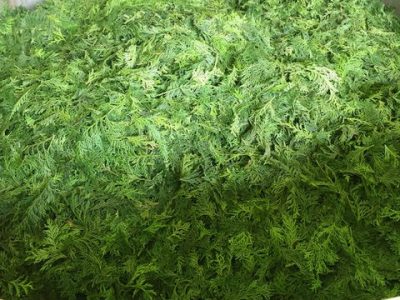Product: Hinoki Oil
Hinoki Oil Japan Chamaecyparis obtusa
-
Description
Hinoki essential oil comes from the Japanese cypress, Chamaecyparis obtusa, and is native to central Japan. This essential oil is obtained by steam distillation from leaves or wood of Chamaecyparis obtusa. In Japan Hinoki means "white cedar"; it also means fire tree as it was and still is used to make fire through friction in the Shinto Shrines.
Hinoki is considered a very high quality timber and one of the “Five Sacred Trees of Kiso.” It has been used historically in building palaces, temples, shrines, baths, and traditional noh theatres.
Hinoki oil has a scent that is uniquely Japanese. The wood is lemon scented, light pinkish-brown in colour, and highly rot and insect resistant. Highly valued by the Japanese, Hinoki forests have been managed and protected since the times of the feudal lords and samurai. Today it is a popular ornamental tree in parks and gardens.
It is a slow-growing tree which grows to 35 m tall with a trunk up to 1 m in diameter. The bark is dark red-brown. The leaves are scale-like, 2–4 mm long, blunt tipped (obtuse), green above, and green below with a white stomatal band at the base of each scale-leaf. The cones are globose, 8–12 mm diameter, with 8–12 scales arranged in opposite pairs.
The aroma of Hinoki oil comforts our mind, body, and spirit. It’s like hiking through a deep forest and quietly facing deep within ourselves. It is a relaxing and sedating essential oil, helping the body and the mind let go of tension and stress. In addition to preventing the development of harmful bacteria, microbes, and fungi, Hinoki essential oil is also a natural insect repellent. This oil blends well with Cypress, Jasmine, Ylang Ylang, Roman Chamomile, Bergamot, Lavender, Cedarwood, Frankincense, Juniper berry, Mandarin, Myrrh, Orange sweet and Tangerine.
-
Product Details
- Botanical name: Chamaecyparis obtusa
- Origin: Japan
- Crop Season: All Year
- Plant/part used: Wood, Leaves and branches
- Method of extraction: Steam Distillation
- TSCA CAS: 91745-97-0
- EINECS: 294-769-1
- INCI Name: Chamaecyparis obtusa oil
- Appearance: Light pinkish brown clear liquid
- Organoleptic Properties: Woody, balsamic, faintly evergreen with a hint of sweetness
- Chemical constituents: Sabinene, Terpinolene, gamma-Terpinene, Linalyl acetate, Bornyl acetate, alpha-Terpinyl acetate, delta-Cadinene, alpha-Muurolene, tau-Cadinol and Hibaene
-
Product Enquiry
To ask us a fair quote for this product, please fill the following form:
 Ultra International B.V.
Ultra International B.V.
